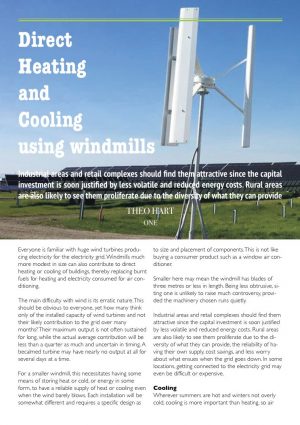 Everyone is familiar with huge wind turbines producing electricity for the electricity grid. Windmills much more modest in size can also contribute to direct heating or cooling of buildings, thereby replacing burnt fuels for heating and electricity consumed for air conditioning.
Everyone is familiar with huge wind turbines producing electricity for the electricity grid. Windmills much more modest in size can also contribute to direct heating or cooling of buildings, thereby replacing burnt fuels for heating and electricity consumed for air conditioning.
The main difficulty with wind is its erratic nature. This should be obvious to everyone, yet how many think only of the installed capacity of wind turbines and not their likely contribution to the grid over many months? Their maximum output is not often sustained for long, while the actual average contribution will be less than a quarter as much and uncertain in timing. A becalmed turbine may have nearly no output at all for several days at a time.
For a smaller windmill, this necessitates having some means of storing heat or cold, or energy in some form, to have a reliable supply of heat or cooling even when the wind barely blows. Each installation will be somewhat different and requires a specific design as to size and placement of components. This is not like buying a consumer product such as a window air conditioner.
Smaller here may mean the windmill has blades of three metres or less in length. Being less obtrusive, siting one is unlikely to raise much controversy, provided the machinery chosen runs quietly.
Industrial areas and retail complexes should find them attractive since the capital investment is soon justified by less volatile and reduced energy costs. Rural areas are also likely to see them proliferate due to the diversity of what they can provide, the reliability of having their own supply, cost savings, and less worry about what ensues when the grid goes down. In some locations, getting connected to the electricity grid may even be difficult or expensive.
Cooling
Wherever summers are hot and winters not overly cold, cooling is more important than heating, so air conditioning is common and a large user of electricity. This is because the air conditioners are usually vapour compressor types powered by an electric motor running for most of each hot day. Air conditioning, at least heavy use of it, is very seasonal.
In Mediterranean lands, summer is when peak electricity use occurs. For example, July is the month of most significant electricity consumption in Italy, and powering all those compressors in the air conditioners is a major reason. Naturally, the electricity grid must be able to meet that peak demand with production that is not needed at any other time. Lowering the summer demand for electricity would be a development welcomed by the grid operator. Wide use of windmill cooling could do it.
The operating sequence of a typical air conditioner is as follows: a refrigerant with a low boiling point enters the cooling coils through an expansion valve and becomes a vapour.
This takes a lot of energy in the form of heat extracted from the air blown over these coils by a fan, hence cool ‘conditioned’ air. Next, the refrigerant vapour within the coils gets sucked into the mechanical compressor, which compacts it back into a hot liquid.
Typically, it is cooled by going through coils that give heat to the outside air. The cooled liquid refrigerant is ready to repeat the cycle by passing through the expansion valve mentioned earlier.
While the above sequence may be efficient and convenient in keeping the components relatively compact, having a liquid phase is not necessary. Even having a gas compressed, cooled, expanded and ejected provides cooling. Rather conveniently for windmill cooling, air may be that gas. The wind is rarely smooth and steady for very long, but stronger or less strong, a bit gusty or turbulent, and the shaft to which a windmill’s blades (vanes) are attached conveys such variation in its rate and force of rotation. With an air compressor attached, what is produced is a variable amount of heated air of a set pressure, governed by a valve. This is no problem for its use in cooling, and hot air has many other benefits besides — be sure the compressor runs quietly.
The compressor is atop the windmill and would deliver a variable though a usually high volume of air at not much pressure (maybe 100 kPa), taking away most of the heat generated by the machine. This would go down the tower in a large diameter pipe, losing heat as it goes, then likely run some distance laterally, perhaps underground, to arrive where it will be expanded, creating cooling.
Usually, this will be within a storage reservoir. A well-insulated cistern of very salty water could be such. It would be a store of coolness for use in air conditioning even when the windmill is not providing much. The saltiness prevents unwanted biological activity. The air from the top of the windmill exits back into the atmosphere. Likely it will be cleaner than what it now mingles with.
Within a building, cooling comes from blowing air over cold pipes or coils in which a transfer fluid (or perhaps the salty water of the cistern itself) flows and returns to the cistern. The speed of the fan regulates the amount of cooling. The reservoir may be nearer the windmill than the building to be cooled, in which case an insulated pipe will carry the cold fluid to it.
The cold fluid could also be used in a heat exchanger to provide cooled drinking water, say in a restaurant or for a drinking fountain. As golf courses are likely places for windmill air conditioning of their clubhouses and caddy shacks, they would also want a cool water fountain at the first tee where players could fill thermoses with cooled water to carry with them.
Windmill cooling is but one way to cool the reservoir, for there is another of ancient pedigree. Evaporative cooling is its label, and a simple example shows how it works. Take a jar of water wrapped in a damp cloth and place it anywhere out of direct sunlight, preferably on a window sill. As the cloth dries, the heat absorbed in evaporating the water is drawn from the jar and its contents, so the water in the jar becomes cooled. Rewetting the cloth continues the process, so the water in the jar can become quite cold. Naturally, this works best when the humidity of the air is not high. The ancient Egyptians were likely not the only desert people
to have figured this out.
One way of effecting this for the reservoir is to have a small exit fan suck humid air from above the water and blow it outside. Fresh outside air then enters passively to replace it. Having that air immediately in contact with the water’s surface helps have its humidity increase. Some means of preventing the growth of moulds or smelly bacteria would be helpful.
Heating and hot air
Having a windmill run an air compressor may also be a means of heating. Instead of all the hot compressed air being cooled by giving off heat to the atmosphere, much of it could be carried down the tower in a well-insulated pipe and then give its heat to some means of storing it, such as a long run through an enclosed amount of gravel, pebbles, bricks, or the like.
This, combined with what comes directly from the windmill, is a reliable source of hot air. Hot air can also come from a solar panel where the sun beats down on a metal tube, which gets blown through the mentioned materials. Solar and wind together would be an even more reliable source of such heat.
Heating a building is seasonal, though hot air used for mainly drying is not — think of a launderette as an instance. However, some drying is indeed seasonal. Certain crops that farmers grow are routinely dried upon harvest, typically using fossil fuels to provide the hot air. Here, hot air from the windmill would prove very useful. Also, where the growing season is often rainy, farmers must dry their hay.
An air compressor is not, of course, the only means of creating heat from a windmill. Frictional heating also arises from swirling a blade, spoon, or similar object in a liquid. The more rapid and more prolonged and turbulent the action, the greater and quicker heating will occur. The temperature of the liquid rises accordingly.
Frictional heating also arises by churning some working fluid within a casing until it reaches the temperature at which a release valve opens to allow some hot liquid out while drawing cool fluid in. This would be driven from the windmill’s shaft and likely located at the base of the windmill tower.
A surge tank, well-insulated, accumulates these intermittent releases to reach a volume of heated fluid sufficient for its uses. This is the most straightforward application, mainly where the need for heat is relatively large for many months. Somewhere with wet, windy winters is an excellent example. Should a ground-source heat pump already appear an attractive investment there, due to security of supply and freedom from price swings in purchased fuel, adding heating from a windmill would offer even greater security. It would also change the composition of the fixed investment, with less looping needed underground, though, of course, the windmill is another expense. But it is a long-term investment that avoids using purchased fuel, thus reducing future costs.
Moreover, it can also provide hot water in addition to room heating by adjusting the trip point of the release valve upward and having it sent through tubing in a tank of water, thereby heating it. So for any place where much hot water is being used, this could substitute for most, perhaps all, of the current expense in providing the same.
When the heating of buildings is not needed, this hot fluid may be run through the ground loops to give up heat to the ground, which becomes a reservoir of it. Warmer soil helps the following winter by making ground loop heating more effective. This presumes that only the churning heater is connected to the windmill’s shaft.
There are many options to consider when it comes to windmill heating and cooling, particularly the placement of the main components. Nonetheless, some standardised designs sizing the major components in an appropriate relationship are sure to arise because this simplifies matters for the buyer. Which is a good thing, as the more of these that get built, the less electricity will be used for cooling and the less fuel burnt for heating, and the less dependent these people will be on overly centralised systems.
Theo Hart


